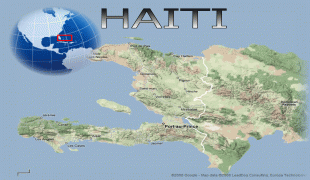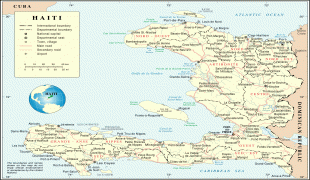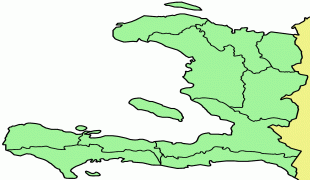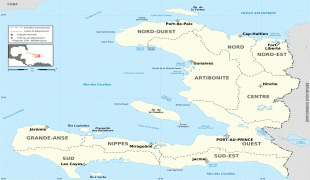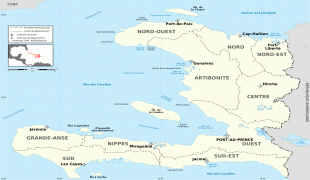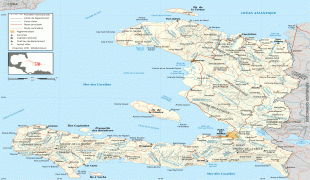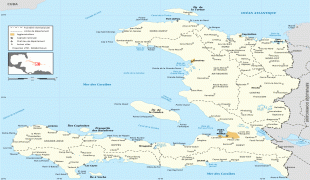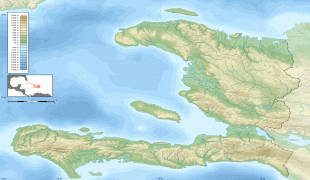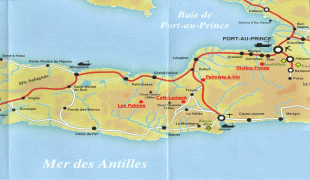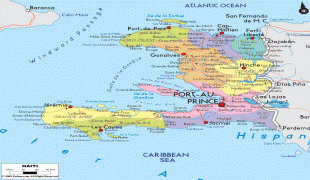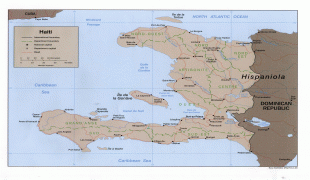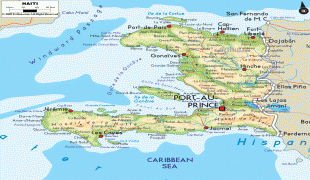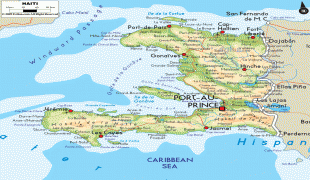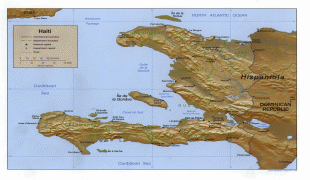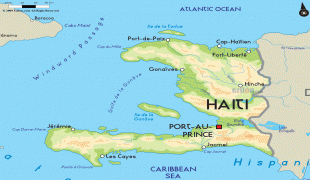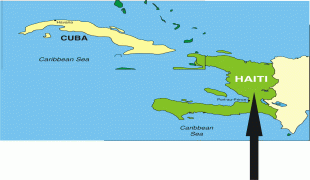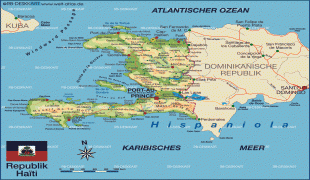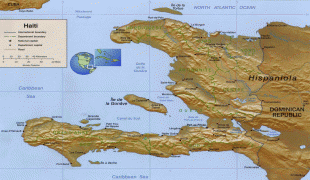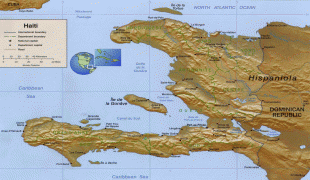Haiti (Republic of Haiti)
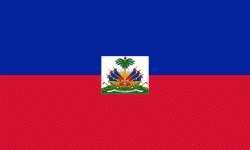 |
 |
| Flag of Haiti | |
The island was originally inhabited by the indigenous Taíno people, who originated in South America. The first Europeans arrived on 5 December 1492 during the first voyage of Christopher Columbus, who initially believed he had found India or China. Columbus subsequently founded the first European settlement in the Americas, La Navidad, on what is now the northeastern coast of Haiti. The island was claimed by Spain and named La Española, forming part of the Spanish Empire until the early 17th century. However, competing claims and settlements by the French led to the western portion of the island being ceded to France in 1697, which was subsequently named Saint-Domingue. French colonists established lucrative sugarcane plantations, worked by vast numbers of slaves brought from Africa, which made the colony one of the richest in the world.
In the midst of the French Revolution (1789–99), slaves, maroons, and free people of color launched the Haitian Revolution (1791–1804), led by a former slave and the first black general of the French Army, Toussaint Louverture. After 12 years of conflict, Napoleon Bonaparte's forces were defeated by Louverture's successor, Jean-Jacques Dessalines (later Emperor Jacques I), who declared Haiti's sovereignty on 1 January 1804—the first independent nation of Latin America and the Caribbean, the second republic in the Americas, the first country in the Americas to eliminate slavery, and the only state in history established by a successful slave revolt. Apart from Alexandre Pétion, the first President of the Republic, all of Haiti's first leaders were former slaves. After a brief period in which the country was split in two, President Jean-Pierre Boyer united the country and then attempted to bring the whole of Hispaniola under Haitian control, precipitating a long series of wars that ended in the 1870s when Haiti formally recognized the independence of the Dominican Republic.
Haiti's first century of independence was characterized by political instability, ostracism by the international community, and the payment of a crippling debt to France. Political volatility and foreign economic influence in the country prompted the United States to occupy the country from 1915 to 1934. Following a series of short-lived presidencies, François 'Papa Doc' Duvalier took power in 1956, ushering in a long period of autocratic rule continued by his son, Jean-Claude 'Baby Doc' Duvalier, that lasted until 1986; the period was characterized by state-sanctioned violence against the opposition and civilians, corruption, and economic stagnation. After 1986, Haiti began attempting to establish a more democratic political system.
Haiti is a founding member of the United Nations, Organization of American States (OAS), Association of Caribbean States, and the Organisation internationale de la Francophonie. In addition to CARICOM, it is a member of the International Monetary Fund, World Trade Organization, and the Community of Latin American and Caribbean States. Historically poor and politically unstable, Haiti has the lowest Human Development Index in the Americas, as well as widespread slavery. Since the turn of the 21st century, the country has endured a coup d'état, which prompted U.N. intervention, as well as a catastrophic earthquake that killed over 250,000 people and a cholera outbreak. With its deteriorating economic situation, as well as recent calls by the IMF to cut fuel subsidies, Haiti has been experiencing a socioeconomic and political crisis marked by riots and protests, widespread hunger, and increased gang activity. As of February 2023, Haiti has no elected government officials and has been described as a failed state.
Haiti (also earlier Hayti) comes from the indigenous Taíno language, in which it means "land of high mountains" and named the entire island of Hispaniola. The name was restored by Haitian revolutionary Jean-Jacques Dessalines as the official name of independent Saint-Domingue, as a tribute to the Amerindian predecessors.
In French, the ï in Haïti has a diacritical mark (used to show that the second vowel is pronounced separately, as in the word naïve), while the H is silent. (In English, this rule for the pronunciation is often disregarded, thus the spelling Haiti is used.) There are different anglicizations for its pronunciation such as HIGH-ti, high-EE-ti and haa-EE-ti, which are still in use, but HAY-ti is the most widespread and best-established. In French, Haiti's nickname means the "Pearl of the Antilles" (La Perle des Antilles) because of both its natural beauty and the amount of wealth it accumulated for the Kingdom of France. During the 18th century, the colony was the world's leading producer of sugar and coffee.
In Haitian Creole, it is spelled and pronounced with a y but no H: Ayiti.
Another theory on the name Haiti is its origin in African tradition, in Fon language one of the most spoken by the bossales (Haitians born in Africa to differentiate from the creoles or Haitians born in Haiti (St-Domingue) in early Haiti, Ayiti-Tomè means: From nowadays this land is our land.
In the Haitian community the country has multiple nicknames: Ayiti-Toma (as its origin in Ayiti Tomè), Ayiti-Cheri (Ayiti my Darling), Tè-Desalin (Dessalines' Land) or Lakay (Home).
Currency / Language
| ISO | Currency | Symbol | Significant figures |
|---|---|---|---|
| HTG | Haitian gourde | G | 2 |
| USD | United States dollar | $ | 2 |
| ISO | Language |
|---|---|
| FR | French language |
| HT | Haitian Creole language |






